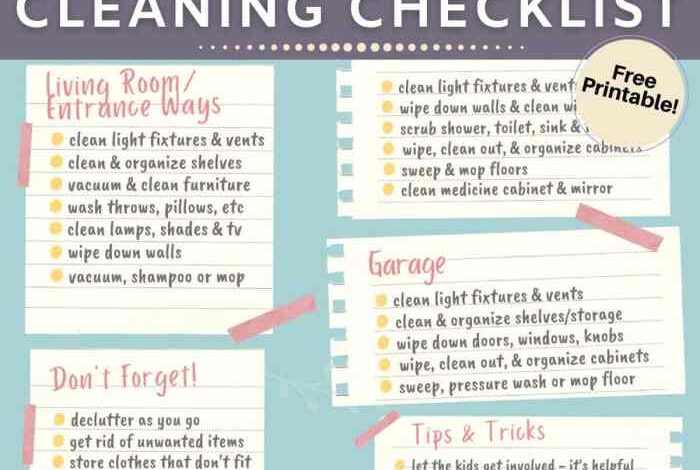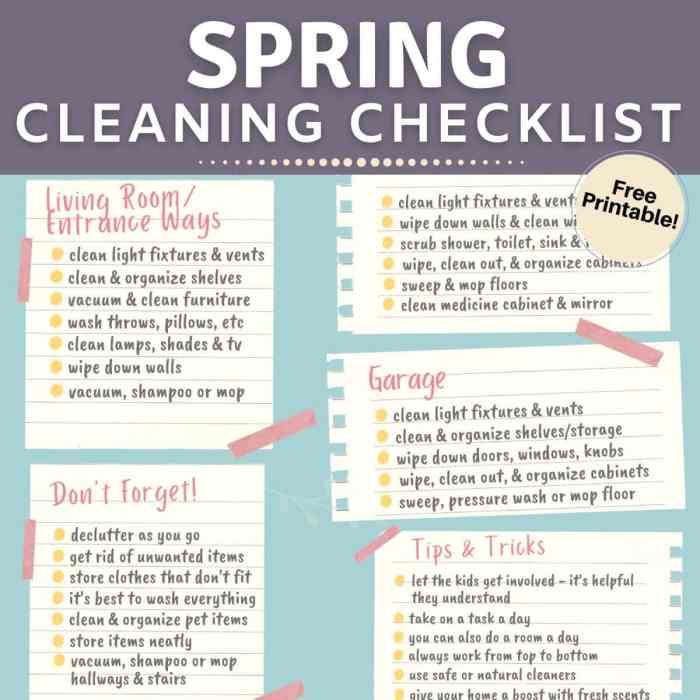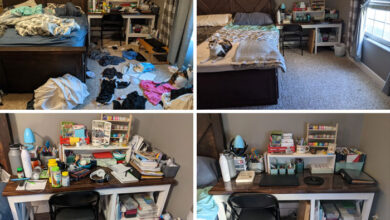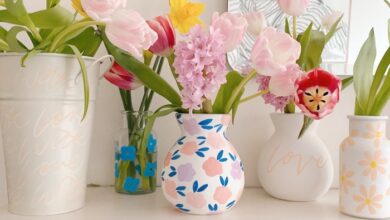
Over 100 Spring Cleaning Tips and Tricks: Your Guide to a Sparkling Home
Over 100 Spring Cleaning Tips and Tricks: Your Guide to a Sparkling Home – Spring is the perfect time to refresh your home and get rid of the winter blues. It’s a chance to declutter, deep clean, and create a space that feels fresh and inviting.
Whether you’re a seasoned cleaning pro or a newbie to the world of spring cleaning, this comprehensive guide has something for everyone.
From decluttering and organizing to cleaning specific rooms and tackling tough stains, we’ll cover it all. We’ll also share time-saving hacks, budget-friendly tips, and advice on creating a healthy and happy home environment. So, grab your cleaning supplies, put on some upbeat music, and let’s get started!
Cleaning the Kitchen
The kitchen is the heart of the home, where meals are prepared and memories are made. Keeping it clean and organized is essential for both hygiene and functionality. Here’s a comprehensive guide to tackling your kitchen cleaning tasks effectively.
Daily Kitchen Cleaning Schedule
A daily cleaning routine can help prevent dirt and grime from accumulating, making deep cleaning easier. Here’s a sample schedule:
- Wipe down countertops and sink:After each meal, use a disinfectant spray or a solution of warm water and dish soap to wipe down your countertops and sink. This prevents food spills and bacteria from spreading.
- Clean the stovetop:Remove any spills or splatters from the stovetop immediately after cooking. Use a stovetop cleaner or a baking soda paste for stubborn stains.
- Wash dishes:Don’t let dishes pile up! Wash them immediately or load the dishwasher after each meal.
- Sweep or vacuum the floor:Remove crumbs and debris from the floor daily to prevent them from accumulating.
- Empty the trash:Take out the trash regularly to prevent odors and attract pests.
Deep Cleaning the Refrigerator and Freezer
A clean refrigerator and freezer are essential for food safety and freshness.
- Empty the refrigerator:Remove all food items, condiments, and shelves.
- Clean the interior:Use a baking soda solution (1 tablespoon baking soda per quart of warm water) to clean the interior of the refrigerator and freezer. Wipe down shelves, drawers, and walls thoroughly.
- Clean the door and seals:Clean the door and seals with a damp cloth and mild detergent.
- Check for leaks:Look for any signs of leaks or condensation. If you find any, clean them up immediately and address the source of the leak.
- Organize and restock:Return food items to the refrigerator and freezer, organizing them by expiration dates.
Cleaning and Maintaining Appliances, Over 100 spring cleaning tips and tricks
Appliances like ovens, microwaves, and dishwashers require regular cleaning to maintain their performance and prevent damage.
Cleaning the Oven
- Remove the oven racks:Remove the racks and wash them in the sink with warm, soapy water.
- Clean the interior:For a self-cleaning oven, follow the manufacturer’s instructions. For a traditional oven, use a commercial oven cleaner or a baking soda paste to clean the interior.
- Clean the door:Wipe down the oven door with a damp cloth and mild detergent.
Cleaning the Microwave
- Clean the interior:Use a damp cloth and mild detergent to clean the interior of the microwave. For stubborn stains, fill a microwave-safe bowl with water and a few slices of lemon. Microwave for a few minutes, then let the steam loosen the stains before wiping clean.
- Clean the turntable:Wash the turntable in the sink with warm, soapy water.
Cleaning the Dishwasher
- Clean the filter:Remove and clean the filter regularly to prevent food particles from clogging the dishwasher.
- Run a cleaning cycle:Use a dishwasher cleaning tablet or a mixture of vinegar and baking soda to run a cleaning cycle.
Cleaning and Organizing Pantry Shelves and Drawers
A clean and organized pantry is essential for efficient food storage and easy access.
- Empty the pantry:Remove all items from the shelves and drawers.
- Clean the shelves and drawers:Use a damp cloth and mild detergent to clean the shelves and drawers.
- Organize the items:Return the items to the pantry, organizing them by category and expiration dates.
- Use storage containers:Use clear storage containers to store dry goods, snacks, and other pantry items. This helps keep items organized and visible.
Cleaning the Bathroom
The bathroom, a haven for relaxation and personal hygiene, can quickly become a breeding ground for bacteria and grime if not properly maintained. From the shower to the toilet, each surface requires specific cleaning techniques to ensure a sparkling and sanitary environment.
With over 100 spring cleaning tips and tricks, you’ll be sure to find something to tackle every corner of your home. One of my favorites is using a floating frame tutorial like this one to display artwork or photos in a unique and modern way.
It’s a great way to refresh your decor and create a fresh look without spending a lot of money. After you’ve tackled the big cleaning tasks, try this simple DIY project for a little creative boost!
Here’s a comprehensive guide to cleaning your bathroom effectively.
Cleaning the Shower and Bathtub
A clean shower and bathtub are essential for a hygienic bathroom. Here’s how to tackle these surfaces:
- Prepare the area:Clear the shower or bathtub of any personal items, such as shampoo bottles or towels. This allows for better access to all surfaces.
- Pre-clean with a mild cleaner:Use a spray bottle filled with a mild cleaner, like dish soap diluted with water, to loosen dirt and grime. Spray the entire surface and let it sit for a few minutes.
- Scrub the surfaces:Using a soft-bristled brush, scrub the shower walls, floor, and bathtub thoroughly. Pay special attention to corners and crevices where grime can accumulate.
- Rinse thoroughly:Rinse the entire shower or bathtub with clean water to remove all traces of cleaner and grime.
- Dry the surfaces:Wipe the shower and bathtub dry with a clean towel or squeegee to prevent water spots and mildew growth.
Removing Hard Water Stains and Mildew
Hard water stains and mildew can be stubborn, but there are effective ways to remove them:
- Hard Water Stains:
- Vinegar:Apply white vinegar to the affected area and let it sit for 30 minutes. Then, scrub with a soft-bristled brush and rinse thoroughly.
- Baking Soda:Make a paste of baking soda and water, apply it to the stains, and let it sit for 30 minutes. Then, scrub with a soft-bristled brush and rinse thoroughly.
- Commercial Cleaners:Use a commercial hard water stain remover, following the instructions on the product label.
- Mildew:
- Bleach Solution:Mix a solution of one part bleach to ten parts water. Apply the solution to the mildew-affected areas, let it sit for 10 minutes, and then scrub with a soft-bristled brush. Rinse thoroughly with clean water.
- Tea Tree Oil:Dilute tea tree oil with water in a spray bottle and apply it to the mildew. Let it sit for 15 minutes, then scrub with a soft-bristled brush and rinse thoroughly.
- Baking Soda:Make a paste of baking soda and water, apply it to the mildew, and let it sit for 30 minutes. Then, scrub with a soft-bristled brush and rinse thoroughly.
Cleaning and Disinfecting Toilets
The toilet is a breeding ground for bacteria, so proper cleaning and disinfecting are crucial:
- Pre-clean the toilet bowl:Use a toilet brush to scrub the inside of the bowl, paying special attention to the rim and under the edge.
- Apply a toilet bowl cleaner:Pour a toilet bowl cleaner into the bowl, making sure to coat the entire surface. Let it sit for 10 minutes, then scrub with a toilet brush.
- Clean the exterior:Wipe the exterior of the toilet with a disinfectant cleaner, paying attention to the seat, lid, and base.
- Disinfect the handle:Use a disinfectant wipe to clean the toilet handle, as it is frequently touched.
- Flush the toilet:Flush the toilet several times to ensure all cleaner is removed.
Maintaining Bathroom Fixtures and Accessories
Regular maintenance of bathroom fixtures and accessories can prevent problems and extend their lifespan:
- Showerhead:Clean the showerhead regularly to prevent mineral buildup and improve water flow. You can soak the showerhead in a vinegar solution or use a commercial showerhead cleaner.
- Faucet:Wipe down the faucet regularly with a damp cloth to remove dirt and fingerprints.
- Mirrors:Clean mirrors with a glass cleaner and a microfiber cloth to prevent streaks and smudges.
- Wastebasket:Empty the wastebasket regularly and disinfect it with a disinfectant cleaner.
Cleaning the Bedroom
The bedroom is a sanctuary, a place to rest and recharge. To truly enjoy this space, it needs to be clean and inviting. Here’s a guide to refresh your bedroom and create a relaxing atmosphere.
Refreshing Bedding and Linens
Regularly washing and changing your bedding is crucial for hygiene and a comfortable sleep environment. Here are some tips to ensure your bedding is clean and fresh:
- Wash sheets, pillowcases, and blankets in hot water at least once a week, or more often if you sweat heavily or have pets.
- Use a gentle detergent and avoid fabric softeners, which can trap dust and allergens.
- Dry bedding on a low heat setting or air dry to prevent shrinkage and damage.
- Rotate your mattress regularly to ensure even wear and tear.
- Vacuum your mattress every few months to remove dust mites and allergens.
- Consider using a mattress protector to shield your mattress from spills and stains.
Cleaning and Organizing Nightstands, Dressers, and Closets
A cluttered nightstand or overflowing dresser can create a sense of chaos in your bedroom. Here’s a checklist for cleaning and organizing these areas:
- Clear off all items from your nightstand and dresser.
- Dust and wipe down surfaces with a damp cloth.
- Organize drawers by category, such as clothing, accessories, or personal items.
- Use drawer dividers to keep items separated and organized.
- Declutter your closet by removing items you no longer wear or need.
- Organize clothes by category and color.
- Use hangers to maximize space and keep clothes wrinkle-free.
- Store off-season items in labeled containers or bins.
Cleaning and Maintaining Mattresses
A clean mattress is essential for a healthy and comfortable sleep. Here’s a guide to keeping your mattress clean and free of dust mites and allergens:
- Vacuum your mattress regularly, at least every few months.
- Spot clean stains immediately with a mild detergent and water.
- Air out your mattress regularly by opening windows and letting fresh air circulate.
- Consider using a mattress protector to shield your mattress from spills and stains.
- Rotate your mattress every few months to ensure even wear and tear.
Dusting and Cleaning Windows and Mirrors
Clean windows and mirrors reflect light and create a sense of spaciousness in your bedroom. Here are some tips for cleaning these surfaces:
- Use a microfiber cloth to dust windows and mirrors before cleaning.
- Mix equal parts water and white vinegar in a spray bottle.
- Spray the solution onto the windows and mirrors.
- Wipe the surfaces clean with a microfiber cloth.
- Dry the windows and mirrors with a clean, dry cloth.
Cleaning the Living Room and Other Common Areas
The living room is often the heart of the home, where families gather, entertain guests, and relax. Keeping this space clean and organized is essential for a comfortable and welcoming environment. This section will guide you through the process of cleaning furniture, carpets, and rugs, as well as dusting and cleaning shelves, bookshelves, and décor items.
We’ll also cover how to clean and maintain windows and mirrors, and offer advice on cleaning and organizing entertainment systems and electronics.
Cleaning Furniture
Regular cleaning of furniture is crucial to maintaining its appearance and longevity. Dusting and vacuuming are essential steps for removing dirt and debris. Here’s a step-by-step guide for cleaning different types of furniture:
- Upholstered furniture:Vacuum regularly using an upholstery attachment to remove dust and loose particles. For deeper cleaning, use a fabric cleaner specifically designed for your furniture type. Follow the manufacturer’s instructions carefully.
- Leather furniture:Dust regularly with a soft cloth. For deeper cleaning, use a leather cleaner and conditioner.
Avoid using harsh chemicals or abrasive cleaners.
- Wooden furniture:Dust regularly with a soft cloth. For deeper cleaning, use a wood cleaner and polish. Apply in a circular motion and avoid excessive moisture.
Cleaning Carpets and Rugs
Carpets and rugs are prone to accumulating dirt, dust, and allergens. Regular cleaning is essential for maintaining their cleanliness and extending their lifespan. Here are some tips for cleaning carpets and rugs:
- Vacuum regularly:Vacuum your carpets and rugs at least once a week to remove loose dirt and debris.
- Spot clean spills immediately:Blot up spills with a clean cloth or sponge. Avoid rubbing, as this can spread the stain.
- Professional cleaning:Have your carpets and rugs professionally cleaned every 12-18 months to remove deep-seated dirt and allergens.
With over 100 spring cleaning tips and tricks, you’ll be a master of organization in no time! But before you dive into the deep clean, test your visual acuity with a fun challenge – can you spot the difference in these two seemingly identical images?
It’s a great way to warm up your attention to detail, which will come in handy when tackling those hard-to-reach corners and forgotten nooks during your spring cleaning spree.
Dusting and Cleaning Shelves, Bookshelves, and Décor Items
Dusting and cleaning shelves, bookshelves, and décor items regularly helps prevent the accumulation of dust and allergens. Here are some tips for cleaning these surfaces:
- Dust regularly:Use a soft cloth or a microfiber duster to remove dust from shelves, bookshelves, and décor items.
- Clean shelves:Wipe down shelves with a damp cloth and mild detergent. Dry thoroughly before placing items back.
- Clean décor items:Dust or wipe down décor items according to their material.
Use a gentle cleaner for delicate items.
Cleaning and Maintaining Windows and Mirrors
Clean windows and mirrors contribute to a brighter and more inviting living space. Here are some tips for cleaning and maintaining these surfaces:
- Use a microfiber cloth:Microfiber cloths are excellent for cleaning windows and mirrors as they are highly absorbent and leave no streaks.
- Use a cleaning solution:Mix equal parts water and white vinegar in a spray bottle. This solution effectively removes dirt and grime without leaving streaks.
- Clean in sections:Clean windows and mirrors in sections to avoid streaks. Start at the top and work your way down.
Cleaning and Organizing Entertainment Systems and Electronics
Entertainment systems and electronics can accumulate dust and debris, affecting their performance. Here are some tips for cleaning and organizing these items:
- Unplug devices:Always unplug electronics before cleaning them to prevent electrical shocks.
- Use a soft cloth:Use a soft, dry cloth to dust electronics. Avoid using harsh chemicals or abrasive cleaners.
- Clean vents:Use a vacuum cleaner with a crevice attachment to clean vents and air intakes.
- Organize cables:Use cable ties or organizers to keep cables neat and tidy.
Spring Cleaning for Specific Needs
Spring cleaning isn’t just about getting rid of dust and clutter. It’s also about creating a healthier and happier home for everyone, including our furry friends, allergy sufferers, and little ones. Here, we’ll delve into some spring cleaning tips tailored to specific needs, making your home a more comfortable and enjoyable space for all.
Spring Cleaning with Pets
Pets are an integral part of many families, and their presence can bring joy and companionship. However, their presence also adds to the overall cleaning requirements. Here are some tips for spring cleaning with pets:
- Clean pet beds and bedding regularly. Pet beds can accumulate dust, dander, and allergens, especially for those with sensitive noses. Wash pet beds according to the manufacturer’s instructions, using a pet-friendly detergent. For heavier cleaning, consider using a baking soda and vinegar solution to deodorize and refresh the bedding.
- Vacuum frequently. Pet hair can quickly accumulate on carpets and upholstery, especially during shedding season. Vacuuming frequently helps remove pet hair and prevent it from becoming embedded in the fabric. Consider using a vacuum cleaner with a HEPA filter to capture even the smallest particles of pet dander and allergens.
- Clean surfaces where pets spend time. Pets often leave their mark on furniture, countertops, and floors. Clean these surfaces regularly with pet-friendly cleaning products to remove dirt, stains, and odors. You can use a mixture of white vinegar and water to clean most surfaces, and baking soda can be used to deodorize carpets and upholstery.
- Wash pet toys. Pet toys can also harbor bacteria and allergens. Wash washable toys regularly in the washing machine or dishwasher, according to the manufacturer’s instructions. For non-washable toys, wipe them down with a damp cloth and pet-friendly disinfectant.
- Clean litter boxes and cages. Regularly cleaning litter boxes and cages is essential for maintaining a healthy environment for both your pet and your family. Litter boxes should be scooped daily and cleaned thoroughly at least once a week. Cages should be cleaned according to the manufacturer’s instructions, using pet-friendly cleaning products.
Over 100 spring cleaning tips and tricks can seem overwhelming, but it’s all about breaking it down. Organizing your kid’s hair bows is a great place to start, and I found some fantastic inspiration for that in this article on 7 ideas for hair bow holders.
Once you’ve tackled the bows, you’ll be well on your way to conquering the rest of your spring cleaning goals!
Spring Cleaning for Allergy Sufferers
Spring cleaning can be a challenge for allergy sufferers. Dust, pollen, and other allergens can trigger symptoms like sneezing, coughing, and itchy eyes. Here are some tips to help allergy sufferers navigate spring cleaning:
- Clean with a HEPA filter vacuum cleaner. HEPA filter vacuum cleaners are designed to trap even the smallest particles of dust, pollen, and pet dander, making them ideal for allergy sufferers.
- Use a damp cloth. When dusting, use a damp cloth to trap dust instead of spreading it around. This helps prevent dust particles from becoming airborne and triggering allergy symptoms.
- Clean from top to bottom. When cleaning, start at the top of the room and work your way down. This helps prevent dust and debris from falling onto already cleaned surfaces.
- Avoid using harsh chemicals. Some cleaning products contain harsh chemicals that can irritate allergies. Choose natural cleaning products or create your own solutions using baking soda, vinegar, and water.
- Wash bedding in hot water. Dust mites are a common allergen, and they thrive in warm, humid environments. Washing bedding in hot water kills dust mites and helps reduce allergy symptoms.
- Remove clutter. Clutter can trap dust and allergens. By removing clutter, you create a cleaner and healthier environment for allergy sufferers.
Spring Cleaning with Children
Spring cleaning can be a fun and educational experience for children, teaching them the importance of cleanliness and responsibility. Here are some tips for spring cleaning with children:
- Make it fun. Spring cleaning doesn’t have to be a chore. Turn it into a game by having children help sort toys, donate unwanted items, and wipe down surfaces. You can also make it a competition by seeing who can find the most dust bunnies or organize the most items.
- Give them age-appropriate tasks. Younger children can help with simple tasks like picking up toys, dusting low shelves, or wiping down furniture. Older children can help with more complex tasks like sorting laundry, vacuuming, or cleaning windows.
- Use child-friendly cleaning products. Choose cleaning products that are safe for children to use. There are many natural cleaning products available that are non-toxic and biodegradable.
- Set a timer. To keep children engaged and prevent them from getting overwhelmed, set a timer for each task. This creates a sense of urgency and accomplishment.
- Reward their efforts. Rewarding children for their help with spring cleaning reinforces positive behavior and encourages them to participate in future cleaning tasks.
Cleaning and Maintaining Outdoor Spaces
Spring is the perfect time to revitalize your outdoor spaces. Here are some tips for cleaning and maintaining your yard, patio, and deck:
- Clean up debris. Start by removing any leaves, branches, or other debris that has accumulated over the winter. This will create a clean slate for your outdoor spaces.
- Power wash your patio and deck. Power washing can remove dirt, grime, and mildew from your patio and deck, making them look like new. Just be sure to use the appropriate pressure setting for your surface.
- Clean your outdoor furniture. Clean your outdoor furniture with a mild soap and water solution. You can also use a furniture cleaner specifically designed for outdoor use.
- Remove weeds. Pull weeds from your garden beds and walkways. You can also use a weed killer to prevent weeds from growing back.
- Trim your bushes and trees. Trim your bushes and trees to remove dead branches and shape them. This will help your plants grow healthy and strong.
- Fertilize your lawn. Fertilize your lawn to encourage healthy growth. Choose a fertilizer that is appropriate for your type of grass.
Essential Cleaning Supplies and Tools: Over 100 Spring Cleaning Tips And Tricks

A well-stocked cleaning arsenal is essential for tackling any spring cleaning project. Having the right tools and supplies can make the process more efficient and effective.
Essential Cleaning Supplies
Having the right cleaning supplies is essential for a successful spring cleaning session. Here are some of the must-haves:
- All-purpose cleaner:This is a versatile cleaner that can be used on most surfaces, including countertops, floors, and appliances. Look for a cleaner that is safe for both hard and soft surfaces.
- Glass cleaner:This cleaner is specifically designed for cleaning windows, mirrors, and other glass surfaces. It will leave your surfaces sparkling clean and streak-free.
- Disinfectant cleaner:This cleaner is essential for killing germs and bacteria on surfaces like bathrooms, kitchens, and high-touch areas. Choose a disinfectant that is effective against a wide range of pathogens.
- Bathroom cleaner:This cleaner is specifically designed for cleaning bathrooms and tackling tough stains like mildew and soap scum.
- Floor cleaner:This cleaner is specifically designed for cleaning floors, whether they are hardwood, tile, or laminate. Choose a cleaner that is appropriate for your floor type.
- Carpet cleaner:This cleaner is essential for removing stains, dirt, and odors from carpets. Choose a cleaner that is safe for your carpet type.
- Laundry detergent:This is essential for cleaning clothes, bedding, and other laundry items. Choose a detergent that is effective for your laundry needs.
- Bleach:This is a powerful disinfectant that can be used to clean and sanitize surfaces. Use bleach with caution and always follow the manufacturer’s instructions.
- Vinegar:This is a natural cleaner that can be used for a variety of purposes, including cleaning windows, removing hard water stains, and deodorizing surfaces.
- Baking soda:This is another natural cleaner that can be used to scrub surfaces, deodorize carpets, and clean drains.
Essential Cleaning Tools
The right tools can make cleaning much easier and more effective. Here are some essential cleaning tools:
- Microfiber cloths:These cloths are highly absorbent and can be used for a variety of cleaning tasks. They are also reusable and washable, making them a more sustainable option.
- Sponges:Sponges are versatile cleaning tools that can be used for scrubbing, wiping, and cleaning up spills. Choose sponges that are non-scratch and can be easily sanitized.
- Brushes:Brushes are essential for scrubbing surfaces, cleaning grout, and removing dirt from hard-to-reach areas. Choose brushes with different bristles for different cleaning tasks.
- Mop:A mop is essential for cleaning floors. Choose a mop with a washable head and a handle that is comfortable to use.
- Vacuum cleaner:A vacuum cleaner is essential for cleaning carpets, rugs, and upholstery. Choose a vacuum cleaner with different attachments for different cleaning needs.
- Dustpan and broom:A dustpan and broom are essential for sweeping floors and picking up debris. Choose a dustpan and broom that are lightweight and easy to use.
- Bucket:A bucket is essential for holding cleaning solutions and water. Choose a bucket with a handle for easy carrying.
- Squeegee:A squeegee is essential for cleaning windows and other glass surfaces. Choose a squeegee with a comfortable handle and a blade that is durable and easy to clean.
Using Cleaning Products Effectively
Knowing how to use cleaning products effectively is crucial for achieving optimal results and ensuring safety. Here are some tips:
- Read the label:Always read the label of a cleaning product before using it. This will provide important information about the product’s intended use, dilution instructions, safety precautions, and potential hazards.
- Dilute properly:Most cleaning products need to be diluted with water before use. Follow the dilution instructions on the product label to ensure optimal cleaning performance and avoid damage to surfaces.
- Test in an inconspicuous area:Before using a new cleaning product on a large surface, test it in an inconspicuous area first. This will help you ensure that the product is safe for the surface and will not cause any damage or discoloration.
- Use gloves:Wear gloves when using cleaning products, especially those that contain harsh chemicals. This will protect your skin from irritation and absorption of harmful chemicals.
- Ventilate the area:When using cleaning products, ensure adequate ventilation by opening windows and doors. This will help to reduce the concentration of fumes and minimize the risk of respiratory irritation.
- Store cleaning products properly:Store cleaning products in a cool, dry place, away from children and pets. Keep them in their original containers and ensure the lids are tightly closed.
Making Your Own Natural Cleaning Solutions
Creating your own natural cleaning solutions is a great way to reduce exposure to harsh chemicals and save money. Here are some recipes for effective natural cleaning solutions:
- All-purpose cleaner:Mix equal parts water and white vinegar in a spray bottle. Add a few drops of essential oil, like lemon or tea tree oil, for a fresh scent.
- Glass cleaner:Mix equal parts water and white vinegar in a spray bottle. Add a few drops of dish soap for extra cleaning power.
- Disinfectant cleaner:Mix 1/2 cup white vinegar with 1 cup water in a spray bottle. This solution is effective against a wide range of bacteria and viruses.
- Bathroom cleaner:Mix 1/2 cup baking soda with 1/4 cup white vinegar in a bowl. Apply the paste to surfaces and let it sit for a few minutes before scrubbing with a brush.
- Floor cleaner:Mix 1/2 cup white vinegar with 1 gallon of warm water in a bucket. Mop your floors with this solution for a clean and shiny finish.
- Carpet cleaner:Sprinkle baking soda over your carpet and let it sit for a few minutes before vacuuming. This will help to deodorize and freshen your carpets.
Storing and Organizing Cleaning Supplies
Proper storage and organization of cleaning supplies are crucial for maintaining order and ensuring easy access. Here are some tips:
- Designated cleaning area:Create a designated cleaning area in your home, such as a closet or a cabinet, to store all your cleaning supplies. This will keep everything organized and easily accessible.
- Use shelves and drawers:Utilize shelves and drawers to maximize storage space and keep your cleaning supplies organized. You can use baskets or containers to further categorize items.
- Label containers:Label containers and bottles clearly to identify the contents and make it easier to find what you need. Use permanent markers or labels for easy identification.
- Store cleaning products separately:Store cleaning products separately from other household items, such as food or medications, to prevent accidental contamination or exposure.
- Keep hazardous materials out of reach:Store hazardous materials, such as bleach and ammonia, in a secure location out of reach of children and pets. This will help to prevent accidental poisoning or injury.
Spring Cleaning on a Budget
Spring cleaning doesn’t have to break the bank. With a little creativity and planning, you can achieve a sparkling clean home without sacrificing your financial well-being. This guide will provide tips and tricks to help you spring clean on a budget, focusing on repurposing, saving on supplies, and creating a cost-effective plan.
Repurposing Old Items for Cleaning Tasks
Repurposing old items is an excellent way to save money and reduce waste. Many household items can be used as effective cleaning tools.
- Old Socks:Use old socks to dust delicate items like lampshades or picture frames. You can also fill them with white vinegar and tie them off to create reusable cleaning cloths for tackling tough stains.
- Old T-shirts:Cut up old t-shirts to make reusable cleaning cloths. They’re great for wiping surfaces, cleaning windows, and even polishing furniture.
- Newspaper:Newspaper can be used to clean windows and mirrors. The ink in the newspaper helps to remove grease and grime.
- Plastic Bottles:Repurpose plastic bottles as spray bottles for homemade cleaning solutions.
- Citrus Peels:Use citrus peels to clean and deodorize your garbage disposal.
Saving Money on Cleaning Supplies
You don’t need expensive cleaning products to achieve a sparkling clean home. There are many affordable and effective alternatives available.
- Baking Soda:Baking soda is a natural abrasive that can be used to clean a variety of surfaces, including countertops, sinks, and ovens. It’s also a great deodorizer.
- Vinegar:Vinegar is a natural disinfectant and can be used to clean windows, floors, and even the toilet.
- Lemon Juice:Lemon juice is a natural bleaching agent and can be used to brighten surfaces and remove stains.
- Dish Soap:Dish soap is a versatile cleaning agent that can be used to clean a variety of surfaces, including dishes, floors, and even windows.
Creating a Cost-Effective Spring Cleaning Plan
Planning is essential for a successful and budget-friendly spring cleaning. Here’s a step-by-step guide to creating a cost-effective plan:
- Set Realistic Goals:Don’t try to tackle everything at once. Break down your spring cleaning into manageable tasks.
- Inventory Your Supplies:Take stock of what you already have before purchasing new cleaning supplies. You might be surprised at how much you already have on hand.
- Make a List:Create a list of all the areas you need to clean. This will help you stay organized and avoid missing anything.
- Prioritize Tasks:Focus on the most important tasks first. For example, cleaning the kitchen and bathroom should be a priority.
- Set a Budget:Decide how much you’re willing to spend on cleaning supplies. This will help you stay on track and avoid overspending.
Repurposing Cleaning Supplies
Repurposing cleaning supplies is another way to save money and reduce waste. Here are some ideas:
- Recycle Cleaning Bottles:Wash and reuse empty cleaning bottles for homemade cleaning solutions.
- Use Old Toothbrushes:Old toothbrushes are great for cleaning grout, crevices, and other hard-to-reach areas.
- Repurpose Old Sponges:Cut up old sponges to create reusable cleaning cloths.
Saving Money on Cleaning Services
If you’re looking to save money on cleaning services, consider these options:
- Hire a Professional for Specific Tasks:Instead of hiring a cleaning service for the entire house, consider hiring a professional for specific tasks, such as window cleaning or carpet cleaning.
- Look for Deals and Discounts:Many cleaning services offer deals and discounts, especially during the off-season.
- Consider Bartering:Barter your skills or services for cleaning services.






